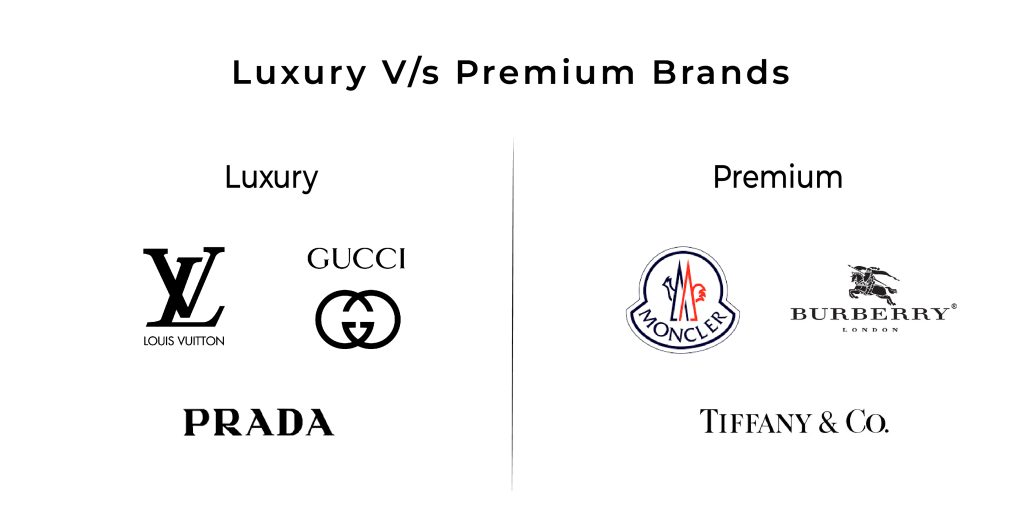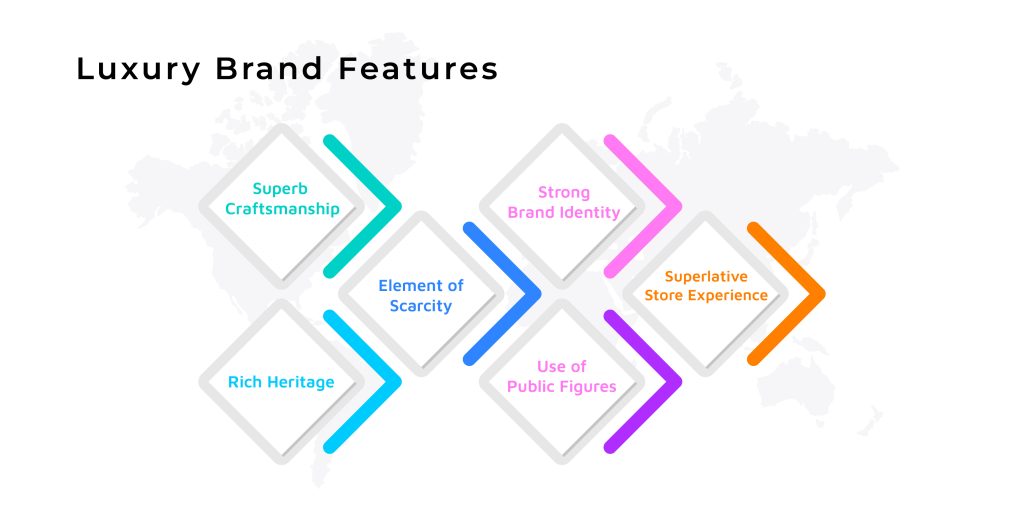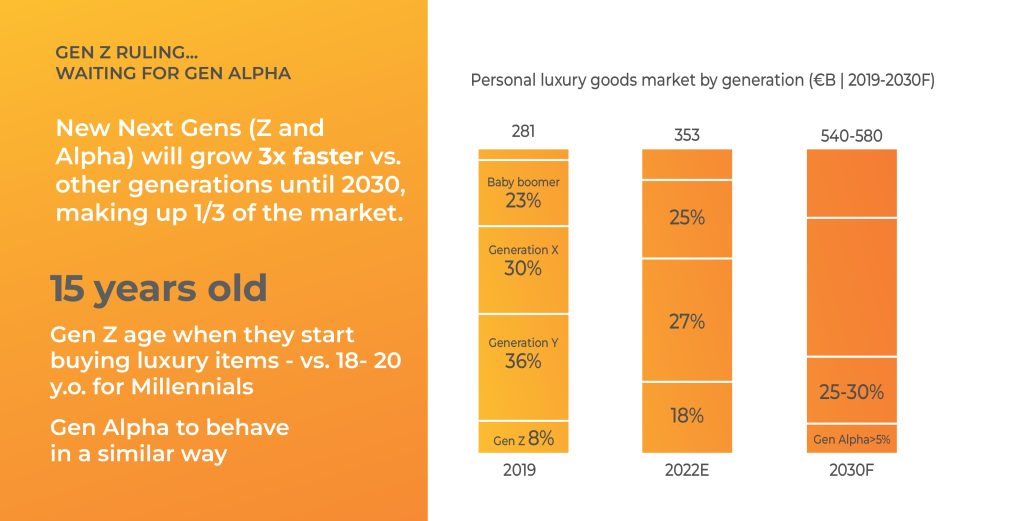A luxury brand can be defined as a brand that is more aware of its quality. In short, it can be categorized as a high-quality and high-priced brand. Generally, luxury brands are present in retail, automotive, and hospitality but fashion luxury brands are brands to follow and learn from.
Fashion luxury brands do not focus on a broad target audience or make their products easily accessible to all consumers, even at premium prices. The foundation of luxury marketing lies in scarcity, creating an aspirational charm. The driving force behind the luxury sector is not only the wealthy but rather, it thrives on individuals aspiring to be part of this exclusive segment. To truly establish itself as a fashion luxury brand, a company must uphold a significant position of exclusivity, scarcity, and other premium attributes.
Luxury vs. Premium
Many individuals tend to conflate luxury and premium brands, assuming their equivalence. However, the key distinction lies in the target audience. Premium brands serve a wide audience, encompassing those seeking quality and willing to pay a higher price for it.
On the other end, luxury brands intentionally avoid appealing to everyone, emphasizing exclusivity. In short, they only target the audience that can afford the luxury. They set prices significantly high, although this does not necessarily correlate with a major increase in quality compared to premium brands. Suppose a luxury brand tries to broaden its market appeal by lowering prices and enhancing accessibility. In that case, it risks compromising its luxury status and losing the crucial element of the brand value.
This distinction is particularly crucial when establishing a clothing field, influencing how the brand is positioned in marketing and pricing strategies. Enrolling in our Foundations of Marketing course can provide valuable insights into the fundamental principles that shape retail buying, merchandising, and pricing decisions.

How Are Luxury Brands Different From Other Brands?
Although we have almost explained the difference between luxury brands and other brands especially premium brands, if you are looking for a one-liner then here it is. Luxury brands are those brands that focus on quality over quantity, have a unique selling approach, have a long history, and are known for their authenticity.
6 Must-Have Fashion Luxury Brand Features
Superb craftsmanship
True luxury is characterized by the use of top-quality materials and meticulous hand-crafting standards that defy easy replication by machines. This commitment to artistry, craftsmanship, and enduring durability not only captivates connoisseurs but also distinguishes the product. For example, Louis Vuitton proudly asserts that each of its suitcases or handbags undergoes over 1,000 stages of meticulous creation before reaching the hands of the consumer. Similarly, Ermenegildo Zegna oversees the production of the fabrics used in their suits through their factories.
Luxury brands frequently commence their journey with skilled teams operating in small workshops, placing artisan craftsmanship at the core of their identity. Gucci, in its 90th-anniversary advertising campaign, underscored this aspect by showcasing black and white photographs from their workshops in the 1950s. This visual narrative emphasized the profound crafting knowledge passed down through generations, reinforcing the brand’s commitment to traditional craftsmanship.
Rich heritage
Luxury brands typically boast a rich history, underscoring their enduring presence and the accumulated knowledge acquired over the years. At times, their allure is intertwined with an extraordinary founder, as exemplified by figures like Coco Chanel or Salvatore Ferragamo. Often, these brands are deeply rooted in a country’s cultural identity; for instance, Savile Row tailors and Rolls Royce leverage their British heritage, while Veuve Clicquot and Cartier unmistakably embody French elegance. The Bulgari logo, with its reference to ancient Rome in its typeface, further exemplifies this cultural connection.
This is why luxury brands frequently highlight their founding date, historical milestones, and noteworthy events throughout their existence. For instance, the fact that Wolsey underwear was worn by both Captain Scott and the Norwegian Roald Amundsen during their 1911 race to the South Pole adds gravitas and legitimacy that newer brands cannot claim.
In the absence of a substantial history, emerging luxury brands must rely on compelling brand stories or strategic brand positioning to establish themselves in the market.
Element of scarcity
The essence of luxury lies in its exclusivity, designed to be beyond the reach of everyone. Consequently, numerous high-end brands deliberately limit product availability. A prime example is the legendary six-year waiting list for the Hermès Birkin bag, underscoring the belief that if something is worth the wait, it is worth possessing. On the contrary, there’s the case of Pierre Cardin, once a highly esteemed couture brand, which, by 1990, flooded the market with over 800 licenses in 94 countries. This strategy led to a loss of control over quality and design, ultimately diminishing the brand’s reputation.
In the 2000s, a novel approach emerged where high-end brands expanded their reach by collaborating with high-street chains. This involved creating limited editions that customers eagerly sought after for a brief period. This approach blends scarcity with a mass-market strategy, instigating desire while safeguarding the brand from overexposure. Consequently, the product, service, or experience becomes more coveted and perceived as more valuable.
Strong brand identity
A luxury brand’s identity must encompass not only its excellence but also its distinctive personality, aura, and attitude. Consequently, these brands are meticulous about aligning themselves with specific causes or perspectives. For instance, Tiffany has become synonymous with the most romantic symbol of love, Liberty embodies the exotic and eclectic, and Lamborghini is positioned as the ultimate toy for the playboy. Each brand endeavors to establish a personal connection with its audience, reflecting their dreams, desires, and the need for recognition.
An example of this strategy can be observed in Tiffany & Co’s printed advertisement, which features the slogan ‘Celebrating the World’s Greatest Love Stories Since 1837.’ In this campaign, models re-enact the iconic scene from the film ‘Breakfast at Tiffany’s,’ starring Audrey Hepburn.
Sponsorship is a prevalent approach, whether in sports (Rolex exclusively sponsors tennis, golf, sailing, and motorsports), film (Omega, Aston Martin, and Brioni are associated with James Bond; Chopard sponsors the Cannes Film Festival), or youth culture (Burberry supports young British bands).
Some luxury brands assert their pre-eminence by establishing foundations (like DvF and Zegna) or aligning themselves with sophisticated pastimes (Chanel with art, Cartier with Polo). Notably, brands such as Prada, Ferragamo, and Rolls Royce have even inaugurated their museums. These associations add interest depth and texture to the brand’s narrative.
Use of public figures
Vivienne Westwood, Donatella Versace, and Richard Branson actively contribute to their brands by embodying their personalities. However, others opt for strategic associations with carefully selected public figures, leveraging these figures to transfer their qualities onto the brand, generating attention and credibility. This widespread practice includes collaborations with film stars (such as Keira Knightley for Chanel and Jude Law for Dunhill), sports personalities (like Rafael Nadal for Lanvin and David Beckham for Armani), singers (Madonna for Smirnoff and Britney Spears for Virgin Mobile), designers, brand owners, politicians, and even royalty.
Louis Vuitton employed a distinctive approach, enhancing its gravitas by partnering with experts in various fields, such as Francis Ford Coppola, Mikhail Gorbachev, and astronaut Buzz Aldrin.
Interestingly, numerous high-end brands have ventured into filmmaking, with Chanel initiating this trend in 2004 through a three-minute mini-film directed by Baz Luhrmann and featuring Nicole Kidman. The film incurred a substantial cost of $42 million. Notably, Tom Ford took it a step further by directing his movie, “A Single Man,” where the characters exclusively wore his creations.
Superlative store experience
Luxury brands have consistently relied on creating exclusive and extraordinary shopping experiences to establish a more profound connection with consumers and evoke positive associations. This explains their initial reluctance to embrace the idea of online shopping, which was perceived as impersonal and accessible to the masses.
When purchasing items like a ring from Cartier, a gown from Valentino, or food from Fortnum & Mason, the experience goes beyond a simple transaction. Luxury brands aim to offer a heightened emotional incentive for making a purchase. For instance, Abercrombie & Fitch and Hollister utilize topless male models, Burberry integrates state-of-the-art interactive technology in the Far East, and Alfred Dunhill pioneers the gentleman’s club-style brand. The latter includes amenities such as a private dining room, cinema, barber, and spa, providing customers with a complete immersion into the brand.
These distinctive features serve as the foundation, imparting the necessary substance and depth for luxury brands to command respect, capture attention, and justify their ability to charge substantial prices.

Gen Z and Heritage Luxury Fashion
Are you wondering why Gen Z favors traditional luxury fashion labels over emerging contemporary brands, despite the latter’s abundance? Here are a few reasons-
- The allure of luxury brands lies significantly in their exclusivity, often manifested through the release of “limited edition” items in collaboration with renowned figures in the fashion world. This limited availability triggers a fear of missing out among Gen Z, prompting them to pay a premium for access to exclusive collections willingly.
- Luxury brands strategically leverage celebrity endorsements to shape their brand identity, enhance credibility, and secure a prominent market position. Celebrities showcasing their luxury fashion acquisitions create a “bandwagon effect,” motivating Gen Z to increase their purchases and align with their reference groups.
- A major motivating factor for Gen Z’s preference for luxury brands is the concept of “conspicuous consumption.” Heritage luxury fashion brands go beyond product quality and price, developing carefully curated visual identities encompassing elements like name, logo, and house codes that remain consistent. This visual language aids in conveying the brand’s aesthetics to consumers, allowing each brand to stand out and be distinguished from others in the luxury market.
- Gen Z follows the products of these luxury brands as symbols of status, allowing them to convey their economic standing to family, friends, and colleagues. Consequently, Gen Z initially opts for iconic items from heritage luxury fashion brands, such as Chanel’s No.5 perfume, Hermès’ Birkin/Kelly bags, and Christian Dior’s New Look. These items, widely recognizable globally by people of all ages, enable observers to associate Gen Z individuals with these prestigious brands.
- The growing enthusiasm for global travel among Gen Z adds to their inclination toward luxury brands. As they aspire to explore the world at a young age, the captivating ambiance and personalized shopping experience offered by flagship stores in upscale fashion districts across popular European and New York cities further allure Gen Z towards making purchases from these brands.
- According to Business Insider, by 2030, Gen Z and Gen Alpha, who were born between 2010 and the early 2020s will make up a third of the luxury fashion market, and spending by these generations is predicted to increase three times faster than older generations, the Bain report states. It found that Gen Zers are buying luxury items at around age 15, which is three to five years earlier than millennials.

Millennials and Gen Z accounted for 72% of the global luxury market in 2022 compared with 2019, when millennials and Generation X made up most of the luxury fashion market, at 66% of the market share, compared with Gen Z’s 8% share.
Recognizing the influential role of Gen Z in the realm of fashion, luxury brands are investing significantly in their social media management to establish connections with this demographic. This strategic approach is driven by the fact that Gen Z not only influences fashion trends for many families but also serves as a source of inspiration. By targeting Gen Z, luxury brands aim to not only heighten awareness among older generations but also stimulate overall sales growth.
How are luxury brands connecting with Gen Z and what can small businesses learn from them?
Gen Z has experienced financial and emotional repercussions due to COVID-19, feeling a sense of loss in a crucial year of their development. This has led to feelings of sadness, frustration, and pessimism about their future. Luxury brands have responded by engaging in social listening to understand Gen Z’s sentiments. They approach Gen Z empathetically, delivering inspiring content centered on personal development. This includes curating book lists, sharing fitness videos, and tapping into Gen Z’s creativity by encouraging them to create reels showcasing their favorite hobbies like art, dance, music, baking, etc.
- To stay relevant in the current climate, luxury brands actively address global issues at the forefront of Gen Z’s concerns. They express their commitment to fair policies, and equal treatment at work, and highlight the local craftsmanship in their manufacturing processes. In response to the pandemic, luxury brands promptly utilized social media to communicate their positive initiatives, aiming to garner goodwill. Major players such as LVMH, Prada, and Chanel have made substantial donations to hospitals, manufactured masks and medical clothing for healthcare professionals, and assured continued remuneration for their employees despite temporary closures, showcasing a commitment to supporting their workforce during the pandemic.
- During the lockdown, Gen Z has been actively finding a sense of purpose in their lives. Increased internet usage has heightened their awareness of the responsibilities of being conscientious citizens of the Earth, prompting a shift in their perspectives on life. With abundant information at their fingertips, Gen Z has gained knowledge and empowerment, enabling them to make informed decisions effortlessly. They prioritize environmentally friendly and sustainable lifestyles. Luxury fashion brands recognize this shift and are actively communicating about their sustainable practices, including inventory management and transparent delivery, to align with Gen Z’s values and make them feel like integral contributors to a larger movement.
Given Gen Z’s dependence on social media, luxury brands have strategically focused on creating online content that captivates their attention. These efforts have proven successful. If you’re a small business seeking effective ways to connect with a younger audience, we’ve distilled some proven strategies from heritage luxury fashion marketing that you can consider adopting.
And don’t worry, they are budget-friendly, we’ve got your back!
We cannot wait for you to implement these strategies in your small businesses, building a large customer base of young individuals!
Final Thoughts
In this blog, we have seen how luxury fashion has been there in the market and then evolved through time. We have covered so many sectors and also the need for performance marketing in the luxury fashion market. Although the brand value speaks for itself making and maintaining a brand value is not easy. In this process, getting help from a professional performance marketing agency is a great idea such as Verve Online Marketing.
Verve Online Marketing is a digital marketing agency. We have delivered our services of PPC, SEO, and SMO to several of our happy clients. The best part of our dedicated team you would like is providing effective digital marketing services to our dozens of clients. We have years of experience to deliver you the outstanding digital marketing services you deserve.
Moreover, we have a single-window solution. Where we deliver the services of logo designing and branding services- connect with us on VerveBranding. For web and app development services, you can connect with us on VerveLogic.






